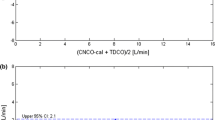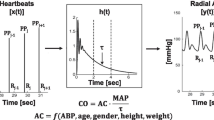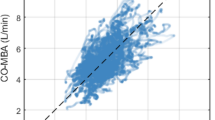Abstract
The CNAP technology (CNSystems Medizintechnik AG, Graz, Austria) allows continuous noninvasive arterial pressure waveform recording based on the volume clamp method and estimation of cardiac output (CO) by pulse contour analysis. We compared CNAP-derived CO measurements (CNCO) with intermittent invasive CO measurements (pulmonary artery catheter; PAC-CO) in postoperative cardiothoracic surgery patients. In 51 intensive care unit patients after cardiothoracic surgery, we measured PAC-CO (criterion standard) and CNCO at three different time points. We conducted two separate comparative analyses: (1) CNCO auto-calibrated to biometric patient data (CNCObio) versus PAC-CO and (2) CNCO calibrated to the first simultaneously measured PAC-CO value (CNCOcal) versus PAC-CO. The agreement between the two methods was statistically assessed by Bland–Altman analysis and the percentage error. In a subgroup of patients, a passive leg raising maneuver was performed for clinical indications and we present the changes in PAC-CO and CNCO in four-quadrant plots (exclusion zone 0.5 L/min) in order to evaluate the trending ability of CNCO. The mean difference between CNCObio and PAC-CO was +0.5 L/min (standard deviation ± 1.3 L/min; 95% limits of agreement −1.9 to +3.0 L/min). The percentage error was 49%. The concordance rate was 100%. For CNCOcal, the mean difference was −0.3 L/min (±0.5 L/min; −1.2 to +0.7 L/min) with a percentage error of 19%. In this clinical study in cardiothoracic surgery patients, CNCOcal showed good agreement when compared with PAC-CO. For CNCObio, we observed a higher percentage error and good trending ability (concordance rate 100%).







Similar content being viewed by others
References
Porhomayon J, El-Solh A, Papadakos P, Nader ND. Cardiac output monitoring devices: an analytic review. Intern Emerg Med. 2012;7:163–71. doi:10.1007/s11739-011-0738-9.
Ganz W, Donoso R, Marcus HS, Forrester JS, Swan HJ. A new technique for measurement of cardiac output by thermodilution in man. Am J Cardiol. 1971;27:392–6. doi:10.1016/0002-9149(71)90436-X.
Swan HJ, Ganz W, Forrester J, Marcus H, Diamond G, Chonette D. Catheterization of the heart in man with use of a flow-directed balloon-tipped catheter. New Engl J Med. 1970;283:447–51. doi:10.1056/NEJM197008272830902.
Rajaram SS, Desai NK, Kalra A, Gajera M, Cavanaugh SK, Brampton W, Young D, Harvey S, Rowan K. Pulmonary artery catheters for adult patients in intensive care. Cochrane Database Syst Rev. 2013;2:CD003408. doi:10.1002/14651858.CD003408.pub3.
Richard C, Monnet X, Teboul JL. Pulmonary artery catheter monitoring in 2011. Curr Opin Crit Care. 2011;17:296–302. doi:10.1097/MCC.0b013e3283466b85.
Kristensen SD, Knuuti J, Saraste A, Anker S, Botker HE, Hert SD, Ford I, Gonzalez-Juanatey JR, Gorenek B, Heyndrickx GR, Hoeft A, Huber K, Iung B, Kjeldsen KP, Longrois D, Luscher TF, Pierard L, Pocock S, Price S, Roffi M, Sirnes PA, Sousa-Uva M, Voudris V, Funck-Brentano C, Authors/Task Force Members. 2014 ESC/ESA guidelines on non-cardiac surgery: cardiovascular assessment and management: the joint task force on non-cardiac surgery: cardiovascular assessment and management of the European Society of Cardiology (ESC) and the European Society of Anaesthesiology (ESA). Eur Heart J. 2014;35:2383–431. doi:10.1093/eurheartj/ehu282.
Alhashemi JA, Cecconi M, Hofer CK. Cardiac output monitoring: an integrative perspective. Crit Care. 2011;15:214. doi:10.1186/cc9996.
Marik PE. Noninvasive cardiac output monitors: a state-of the-art review. J Cardiothor Vasc Anesth. 2013;27:121–34. doi:10.1053/j.jvca.2012.03.022.
Saugel B, Cecconi M, Wagner JY, Reuter DA. Noninvasive continuous cardiac output monitoring in perioperative and intensive care medicine. Br J Anaesth. 2015;114:562–75. doi:10.1093/bja/aeu447.
Thiele RH, Bartels K, Gan TJ. Cardiac output monitoring: a contemporary assessment and review. Crit Care Med. 2015;43:177–85. doi:10.1097/ccm.0000000000000608.
Saugel B, Dueck R, Wagner JY. Measurement of blood pressure. Best Pract Res Clin Anaesthesiol. 2014;28:309–22. doi:10.1016/j.bpa.2014.08.001.
Wagner JY, Grond J, Fortin J, Negulescu I, Schofthaler M, Saugel B. Continuous noninvasive cardiac output determination using the CNAP system: evaluation of a cardiac output algorithm for the analysis of volume clamp method-derived pulse contour. J Clin Monit Comput. 2016;30:487–93. doi:10.1007/s10877-015-9744-1.
Ilies C, Bauer M, Berg P, Rosenberg J, Hedderich J, Bein B, Hinz J, Hanss R. Investigation of the agreement of a continuous non-invasive arterial pressure device in comparison with invasive radial artery measurement. Br J Anaesth. 2012;108:202–10. doi:10.1093/bja/aer394.
Smolle KH, Schmid M, Prettenthaler H, Weger C. The accuracy of the CNAP(R) device compared with invasive radial artery measurements for providing continuous noninvasive arterial blood pressure readings at a medical intensive care unit: a method-comparison study. Anesth Analg. 2015;121:1508–16. doi:10.1213/ane.0000000000000965.
Wagner JY, Prantner JS, Meidert AS, Hapfelmeier A, Schmid RM, Saugel B. Noninvasive continuous versus intermittent arterial pressure monitoring: evaluation of the vascular unloading technique (CNAP device) in the emergency department. Scand J Trauma Resusc Emerg Med. 2014;22:8. doi:10.1186/1757-7241-22-8.
Monnet X, Teboul JL. Passive leg raising: five rules, not a drop of fluid! Crit Care. 2015;19:18. doi:10.1186/s13054-014-0708-5.
Bossuyt PM, Reitsma JB, Bruns DE, Gatsonis CA, Glasziou PP, Irwig L, Lijmer JG, Moher D, Rennie D, de Vet HC, Kressel HY, Rifai N, Golub RM, Altman DG, Hooft L, Korevaar DA, Cohen JF, STARD Group. STARD 2015: an updated list of essential items for reporting diagnostic accuracy studies. BMJ. 2015;351:h5527. doi:10.1136/bmj.h5527.
Montenij LJ, Buhre WF, Jansen JR, Kruitwagen CL, de Waal EE. Methodology of method comparison studies evaluating the validity of cardiac output monitors: a stepwise approach and checklist. Br J Anaesth. 2016;116:750–8. doi:10.1093/bja/aew094.
Bland JM, Altman DG. Statistical methods for assessing agreement between two methods of clinical measurement. Lancet. 1986;1:307–10.
Wagner JY, Negulescu I, Schofthaler M, Hapfelmeier A, Meidert AS, Huber W, Schmid RM, Saugel B. Continuous noninvasive arterial pressure measurement using the volume clamp method: an evaluation of the CNAP device in intensive care unit patients. J Clin Monit Comput. 2015;29(6):807–13. doi:10.1007/s10877-015-9670-2.
Penaz J. (1973) Photoelectric measurement of blood pressure, volume and flow in the finger. Digest of the 10th International Conference on Medical and Biological Engineering, Dresden.
Fortin J, Marte W, Grullenberger R, Hacker A, Habenbacher W, Heller A, Wagner C, Wach P, Skrabal F. Continuous non-invasive blood pressure monitoring using concentrically interlocking control loops. Comput Biol Med. 2006;36:941–57. doi:10.1016/j.compbiomed.2005.04.003.
Fortin J, Wellisch A, Maier K. CNAP—evolution of continuous non-invasive arterial blood pressure monitoring. Biomed Tech. 2013. doi:10.1515/bmt-2013-4179.
Bland JM, Altman DG. Agreement between methods of measurement with multiple observations per individual. J Biopharm Stat. 2007;17:571–82. doi:10.1080/10543400701329422.
Critchley LA, Critchley JA. A meta-analysis of studies using bias and precision statistics to compare cardiac output measurement techniques. J Clin Monit Comput. 1999;15:85–91.
Saugel B, Grothe O, Wagner JY. Tracking changes in cardiac output: statistical considerations on the 4-quadrant plot and the polar plot methodology. Anesth Analg. 2015;121:514–24. doi:10.1213/ane.0000000000000725.
Critchley LA, Lee A, Ho AM. A critical review of the ability of continuous cardiac output monitors to measure trends in cardiac output. Anesth Analg. 2010;111:1180–92. doi:10.1213/ANE.0b013e3181f08a5b.
Vincent JL, Rhodes A, Perel A, Martin GS, Della Rocca G, Vallet B, Pinsky MR, Hofer CK, Teboul JL, de Boode WP, Scolletta S, Vieillard-Baron A, De Backer D, Walley KR, Maggiorini M, Singer M. Clinical review: update on hemodynamic monitoring—a consensus of 16. Crit Care. 2011;15:229. doi:10.1186/cc10291.
Saugel B, Reuter DA. Are we ready for the age of non-invasive haemodynamic monitoring? Br J Anaesth. 2014;113:340–3. doi:10.1093/bja/aeu145.
Thiele RH. Cardiac bulldozers, backhoes, and blood pressure. Anesth Analg. 2015;121:1417–9. doi:10.1213/ane.0000000000000983.
Saugel B, Meidert AS, Langwieser N, Wagner JY, Fassio F, Hapfelmeier A, Prechtl LM, Huber W, Schmid RM, Godje O. An autocalibrating algorithm for non-invasive cardiac output determination based on the analysis of an arterial pressure waveform recorded with radial artery applanation tonometry: a proof of concept pilot analysis. J Clin Monit Comput. 2014;28:357–62. doi:10.1007/s10877-013-9540-8.
Wagner JY, Sarwari H, Schon G, Kubik M, Kluge S, Reichenspurner H, Reuter DA, Saugel B. Radial artery applanation tonometry for continuous noninvasive cardiac output measurement: a comparison with intermittent pulmonary artery thermodilution in patients after cardiothoracic surgery. Crit Care Med. 2015;43:1423–8. doi:10.1097/CCM.0000000000000979.
Broch O, Renner J, Gruenewald M, Meybohm P, Schottler J, Caliebe A, Steinfath M, Malbrain M, Bein B. A comparison of the Nexfin(R) and transcardiopulmonary thermodilution to estimate cardiac output during coronary artery surgery. Anaesthesia. 2012;67:377–83. doi:10.1111/j.1365-2044.2011.07018.x.
Bubenek-Turconi SI, Craciun M, Miclea I, Perel A. Noninvasive continuous cardiac output by the Nexfin before and after preload-modifying maneuvers: a comparison with intermittent thermodilution cardiac output. Anesth Analg. 2013;117:366–72. doi:10.1213/ANE.0b013e31829562c3.
Saugel B, Wagner JY, Reuter DA. Haemodynamic monitoring: the inseparable relation of accuracy and trending. Br J Anaesth. 2015;115:943. doi:10.1093/bja/aev391.
Cecconi M, Rhodes A, Poloniecki J, Della Rocca G, Grounds RM. Bench-to-bedside review: the importance of the precision of the reference technique in method comparison studies—with specific reference to the measurement of cardiac output. Crit Care. 2009;13:201. doi:10.1186/cc7129.
Hapfelmeier A, Cecconi M, Saugel B. Cardiac output method comparison studies: the relation of the precision of agreement and the precision of method. J Clin Monit Comput. 2015;30:149–55. doi:10.1007/s10877-015-9711-x.
Critchley LA. Bias and precision statistics: should we still adhere to the 30% benchmark for cardiac output monitor validation studies? Anesthesiology. 2011;114:1245. doi:10.1097/ALN.0b013e318215e1e5. [author reply 1245–1246].
Peyton PJ, Chong SW. Minimally invasive measurement of cardiac output during surgery and critical care: a meta-analysis of accuracy and precision. Anesthesiology. 2010;113:1220–35. doi:10.1097/ALN.0b013e3181ee3130.
Wagner JY, Saugel B. When should we adopt continuous noninvasive hemodynamic monitoring technologies into clinical routine? J Clin Monit Comput. 2015;29:1–3. doi:10.1007/s10877-014-9619-x.
Acknowledgements
We thank Dr. Doris Flotzinger (CNSystems Medizintechnik AG, Graz, Austria) for her assistance with data extraction. CNSystems Medizintechnik AG (Graz, Austria) provided the technical equipment for the study.
Author information
Authors and Affiliations
Corresponding author
Ethics declarations
Conflict of interest
JYW and BS received refunds of travel expenses from CNSystems Medizintechnik AG (Graz, Austria). BS received honoraria for giving lectures for CNSystems Medizintechnik AG (Graz, Austria). For all other authors there is no conflict to disclose. CNSystems Medizintechnik AG (Graz, Austria) provided the technical equipment for the study.
Research involving Human Participants and/or Animals
This method comparison study was reviewed and approved by the ethics committee (Ethikkomission der Ärztekammer Hamburg, Hamburg, Germany). All procedures performed in studies involving human participants were in accordance with the ethical standards of the institutional and/or national research committee and with the 1964 Helsinki declaration and its later amendments or comparable ethical standards.
Informed consent
Informed consent was obtained from all individual participants included in the study.
Rights and permissions
About this article
Cite this article
Wagner, J.Y., Körner, A., Schulte-Uentrop, L. et al. A comparison of volume clamp method-based continuous noninvasive cardiac output (CNCO) measurement versus intermittent pulmonary artery thermodilution in postoperative cardiothoracic surgery patients. J Clin Monit Comput 32, 235–244 (2018). https://doi.org/10.1007/s10877-017-0027-x
Received:
Accepted:
Published:
Issue Date:
DOI: https://doi.org/10.1007/s10877-017-0027-x




